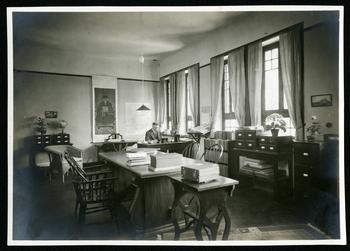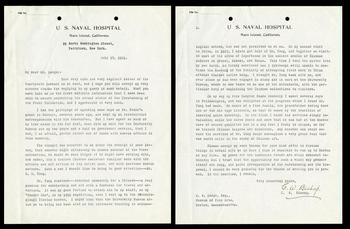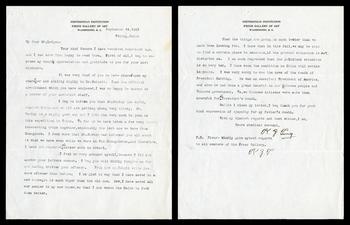As May is Asian Pacific American Heritage Month, I thought that it would be interesting to find out who the first Asian employee of the Smithsonian was. While there is a great deal of research and information about one of the first African American employees of the Smithsonian, Solomon G. Brown, I found that there wasn't really a ready answer to who the first Asian employee was.
Where to start my search? Looking at the history of the Smithsonian Institution, there are some key moments where the possibility of an Asian employee may show up. The first was in 1860, when the first Japanese delegation came to the United States. During their visit some of the delegation members paid Joseph Henry, the first Secretary of the Smithsonian, and the Institution itself a visit. Could it be that the Smithsonian might have hired a translator for the occasion? Alas such was not the case, and in fact, the delegation brought their own translator, so my search continued.
 I also thought that the Section of Oriental Antiquities might have had an Asian employee. The section's creation was precipitated by a letter to Secretary Spencer F. Baird in 1887, "calling attention to the importance of Oriental Archaeology, and more especially Assyriology, and recommending that the National Museum add this to its numerous departments of study and research." The group, which was formally organized on February 2nd, 1888 by Dr. Paul Haupt, Professor of the Semitic Languages at Johns Hopkins University, who served as Honorary Curator; and Dr. Cyrus Adler, Instructor in Semitic Languages Johns Hopkins, who served as Honorary Assistant Curator. However, after researching our collections (such as the above report), to the best of my knowledge no Asian employees worked in the section.
I also thought that the Section of Oriental Antiquities might have had an Asian employee. The section's creation was precipitated by a letter to Secretary Spencer F. Baird in 1887, "calling attention to the importance of Oriental Archaeology, and more especially Assyriology, and recommending that the National Museum add this to its numerous departments of study and research." The group, which was formally organized on February 2nd, 1888 by Dr. Paul Haupt, Professor of the Semitic Languages at Johns Hopkins University, who served as Honorary Curator; and Dr. Cyrus Adler, Instructor in Semitic Languages Johns Hopkins, who served as Honorary Assistant Curator. However, after researching our collections (such as the above report), to the best of my knowledge no Asian employees worked in the section.
In 1906 the collections of Charles Lang Freer were accepted into the Smithsonian and contained major collections of Chinese, Japanese, Egyptian, Near Eastern, and Indian objects. I thought that perhaps an Asian employee could be found at the Smithsonian's Freer Gallery of Art. In fact, there was a joint archaeological expedition made to China by the Freer Gallery of Art and the Museum of Fine Arts, Boston, from February 20, 1923 to August 6, 1927 that seemed like it could be a lead in my research.
 Lead by Carl Whiting Bishop, Assistant Curator at the Freer Gallery of Art, the purpose of the expedition was to forge better relationships between Western archeologists and museums and their Chinese counterparts.
Lead by Carl Whiting Bishop, Assistant Curator at the Freer Gallery of Art, the purpose of the expedition was to forge better relationships between Western archeologists and museums and their Chinese counterparts.

As I dug into the Archives’ records from this expedition, I finally found what could be the first Asian employee. As part of the trip, Bishop hired a field assistant, Kwang-zung Tung. Tung began his appointment with the Freer on July 1, 1923. According to Bishop, Tung had a "real passion for scholarship and art with a fondness for travel and adventure," and felt that "Any curator who could secure the services of Mr. Tung could accomplish a very great deal that was worthwhile in the study of Chinese art." As an Assistant Curator in Oriental Art at the University of Pennsylvania Museum, Bishop had employed Tung on his staff as his "Number One" on his 1915 expedition to China, and then again on his second visit to China in 1917. He was so impressed with Tung, that Bishop saw to it that he be brought to the United States to study and work at the University of Pennsylvania Museum where "he was taken as one of the attendants, with the particular duty of explaining the Chinese collections to visitors."
 However, since Tung was employed specifically for the purposes of the expedition to China, he doesn't qualify as the Smithsonian’s first permanent Asian employee. So who was the first permanent Asian employee? The answer to that question brings us once again to the Freer. Beginning in 1925, Yokichi Kinoshita, from the Museum of Fine Arts, Boston, was hired to come to the Freer to work on the conservation of Japanese paintings. He continued in this capacity until 1932, when the East Asian Painting Conservation Studio was established and he accepted a permanent position at the Freer where he remained until 1950.
However, since Tung was employed specifically for the purposes of the expedition to China, he doesn't qualify as the Smithsonian’s first permanent Asian employee. So who was the first permanent Asian employee? The answer to that question brings us once again to the Freer. Beginning in 1925, Yokichi Kinoshita, from the Museum of Fine Arts, Boston, was hired to come to the Freer to work on the conservation of Japanese paintings. He continued in this capacity until 1932, when the East Asian Painting Conservation Studio was established and he accepted a permanent position at the Freer where he remained until 1950.
While Yokichi Kinoshita is seemingly the first permanent Asian employee at the Smithsonian, he most certainly was not the last. There is a great diversity of employees at the Smithsonian, not just Asian Pacific Americans, but African Americans, Hispanic Americans, and Native Americans, to name a few. As much as the Smithsonian collections reflect the rich history and cultural diversity of the United States, so too do the people who help bring the Smithsonian to the public.
For more information about the Freer expedition to China see the C. W. Bishop Papers held at the Freer Gallery of Art and Arthur M. Sackler Gallery Archives, as well as the records the from expedition held at the Archives.
Special thanks to Pam Henson, Institutional Historian at the Archives; Courtney Esposito, Institutional History Program Assistant; Brian Daniels, Smithsonian Institution Archives (SIA) Fellow; Kae Takarabe, Associate Professor, Chubu University and former SIA Fellow; and Noriko Sanefuji, Curatorial Assistant, Division of Work and Industry, National Museum of American History for their help and assistance in research for this post.
Produced by the Smithsonian Institution Archives. For copyright questions, please see the Terms of Use.


Leave a Comment